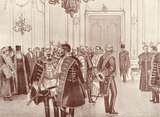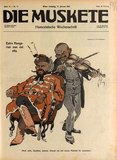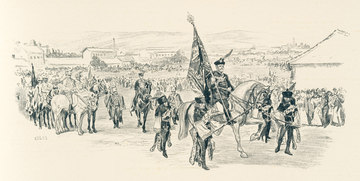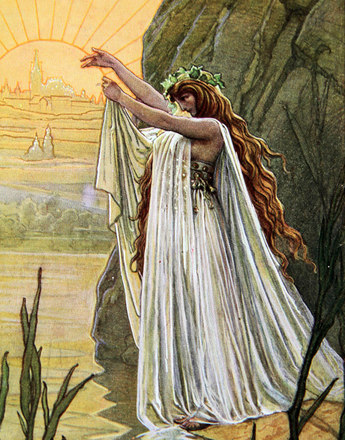-

Viktor Halmi: Hungarian magnates in their costume in the vestibule of Budapest Castle, drawing, 1908
Copyright: Schloß Schönbrunn Kultur-und Betriebsges.m.b.H./Fotograf: Alexander E. Koller
-

Fritz Schönpflug: “Extra Hungaria non est vita”, caricature from: Die Muskete of 31 January 1907
Copyright: ÖNB/ANNO
Partner: Austrian National Library
As in the majority of the Habsburg empire, the aristocracy was the ruling class in Hungary and was able to maintain its political and economic privileges until the First World War. In the process of national development, however, it played a more important role in Hungary than in most of the other nationalities of central Europe.
The Hungarian nobility was not a uniform group. Aristocratic families like the Esterházys, Batthyánys or Pálffys ruled over huge estates and formed not only the social but also the economic elite in this predominantly agrarian country. Although these magnates identified strongly with the Hungarian crown, there was no clear ethnic line and through intermarriage with other aristocratic families within the Monarchy they were also of supranational linguistic and cultural stock. They were loyal to the Habsburg dynasty and in their magnificent robes these high aristocrats contributed to the glory of the Viennese court.
The gentry or county nobility were a peculiar feature within the structure of the Hungarian national society and were much more involved in the nationhood process. Situated between the high aristocracy and the emerging property-owning bourgeoisie, they made up about 5 per cent of the country’s population in the nineteenth century.
These rural gentry (‘dzsentri’, the Hungarian version of the English word, even became part of the language) originated in the ‘comitatuses’, as the administrative units in the kingdom were called. Although often with very small landholdings, the gentry nevertheless dominated the civil service and were the predominant class, particularly in the provinces. Their lifestyle and cultural habits acted as a guideline for the Hungarian national society.
At the start of the process of political nationhood the gentry replaced the absent bourgeoisie and became the effective driving force behind the national movement. The aristocratic ruling class adapted the principles of liberalism for their own purposes. This resulted in the formation of a specific aristocratic national liberalism in which the claims to nationhood were promoted but the democratic and emancipatory elements ignored.
The uncompromising attachment to Magyardom made the gentry into the vanguard of the Magyar nation state even in those parts of the country where other languages predominated, and into bastions of chauvinistic nationalism that looked down in scorn at the attempts at emancipation by ethnic minorities.
The national awareness of the gentry was also above all a class awareness. They sought to defend the old privileges and rights, and for that reason the new economic and social developments were regarded with great scepticism. Around 1900 the proud gentry found themselves in competition with the emerging urban middle class and particularly with the ascendant Jewish bourgeoisie. This created a social climate characterized by militant conservatism with anti-Semitic and chauvinistic undertones.
Translation: Nick Somers
Hanák, Péter: Die Geschichte Ungarns. Von den Anfängen bis zur Gegenwart, Essen 1988
Lukacs, John: Ungarn in Europa. Budapest um die Jahrhundertwende, Berlin 1990
Markus, Adam: Die Geschichte des ungarischen Nationalismus, Frankfurt/Main u. a. 2013
Tóth, István György (Hrsg.): Geschichte Ungarns, Budapest 2005
-
Chapters
- The Magyars and the Habsburg Monarchy
- From ‘Natio Hungarica’ to Magyar nation
- Pride of the nation: the Hungarian nobility
- The Hungarian war of independence 1848/49
- From neo-absolutism to Compromise
- Élyen a Magyar – long live the Magyars! Hungarian Magyarization policy
- The crisis of dualism
- István Graf Tisza: Hungary’s ‘strong man’



